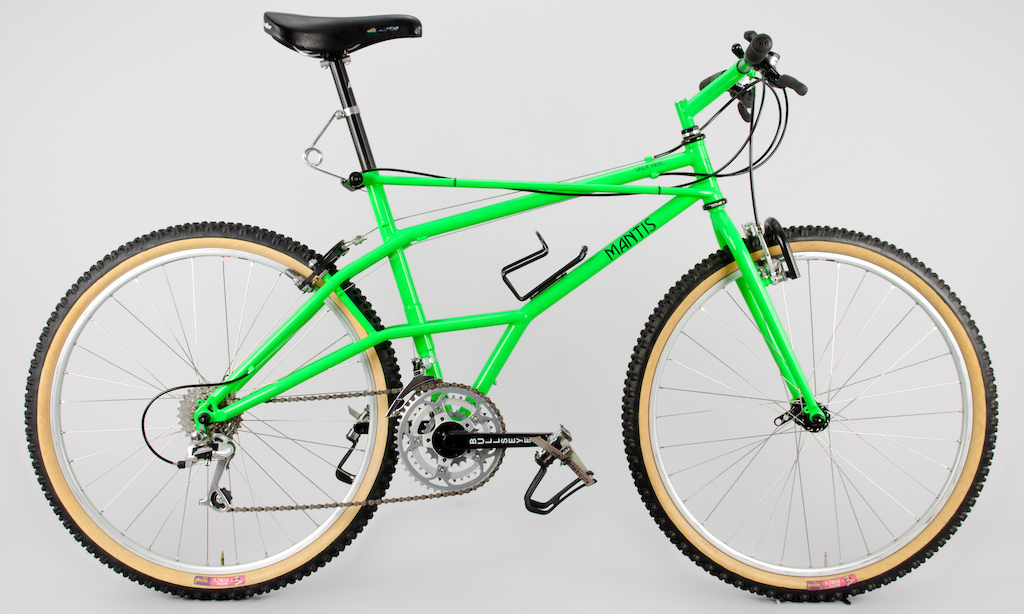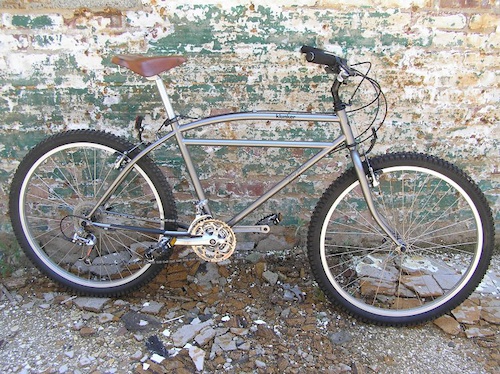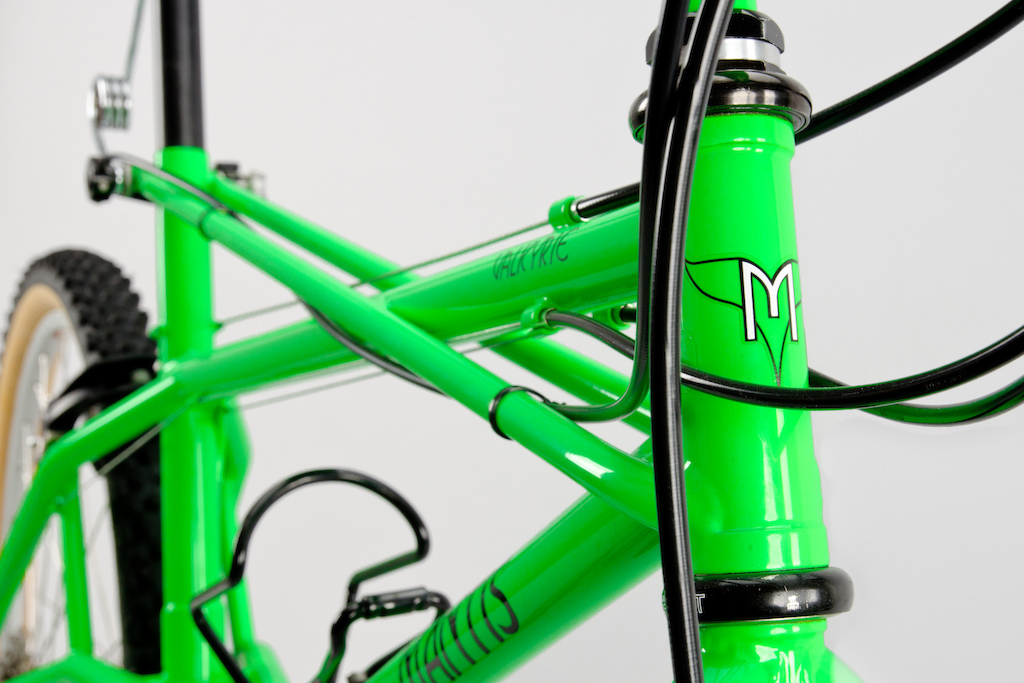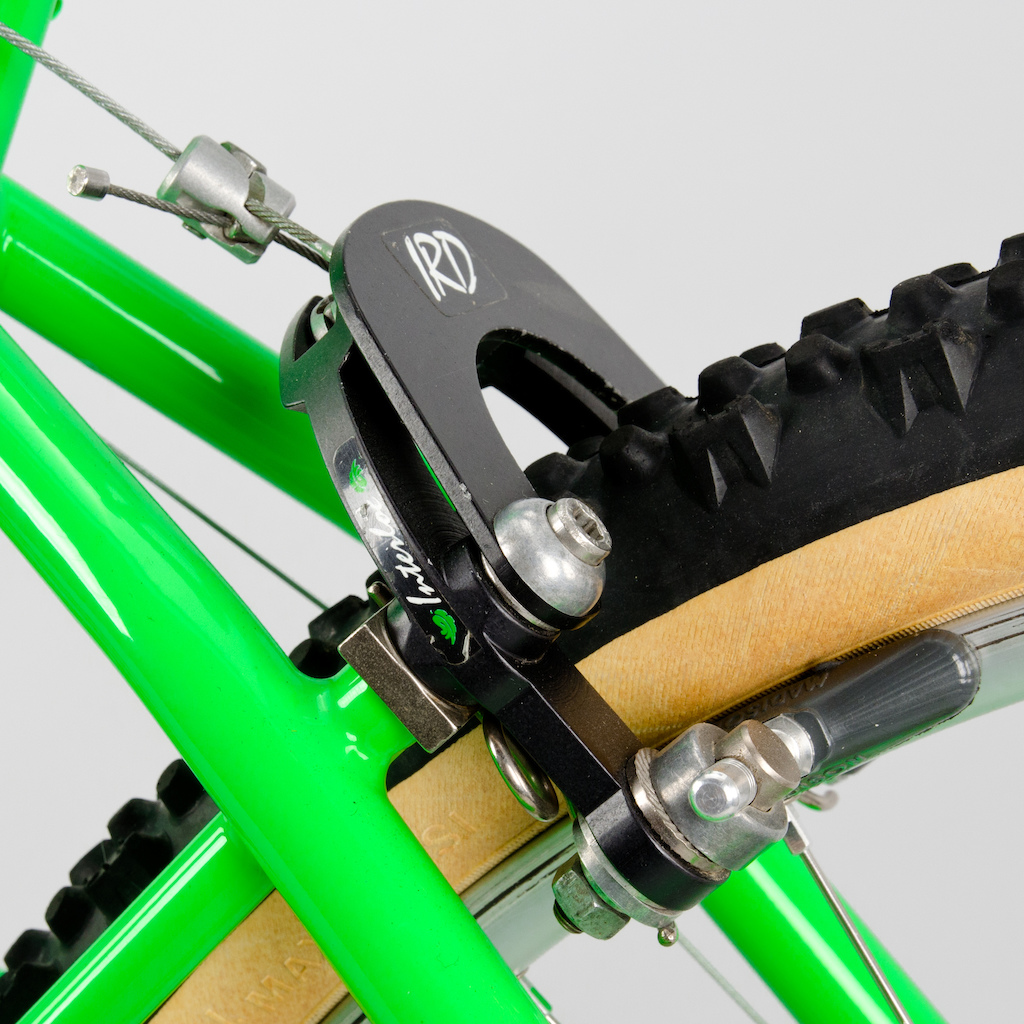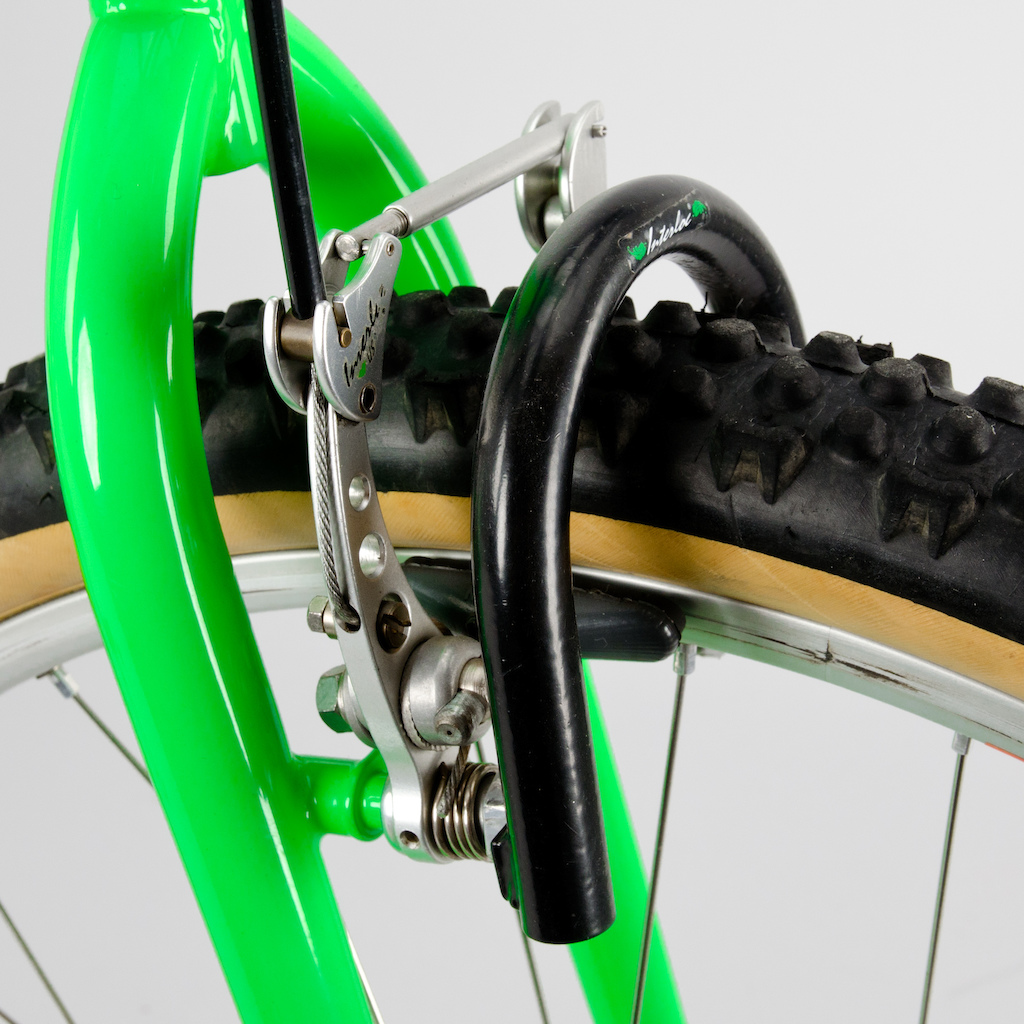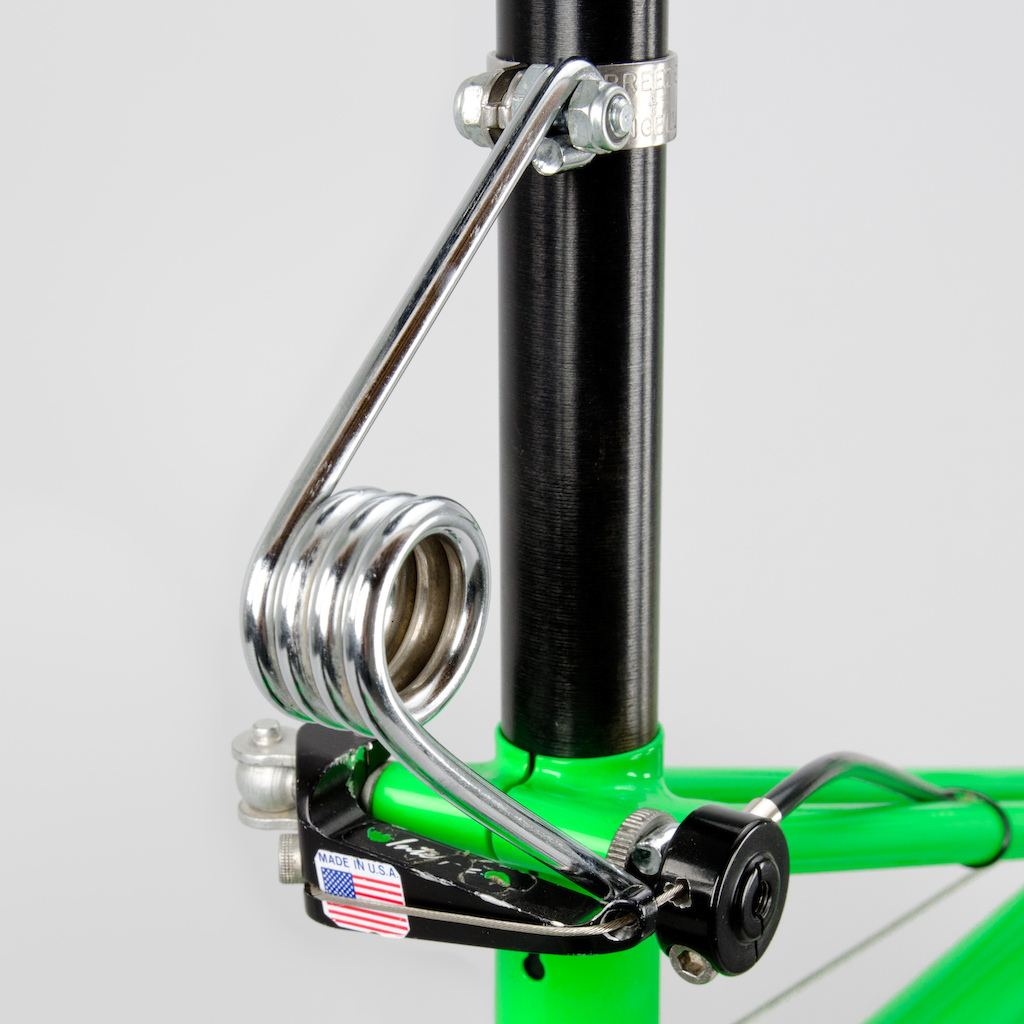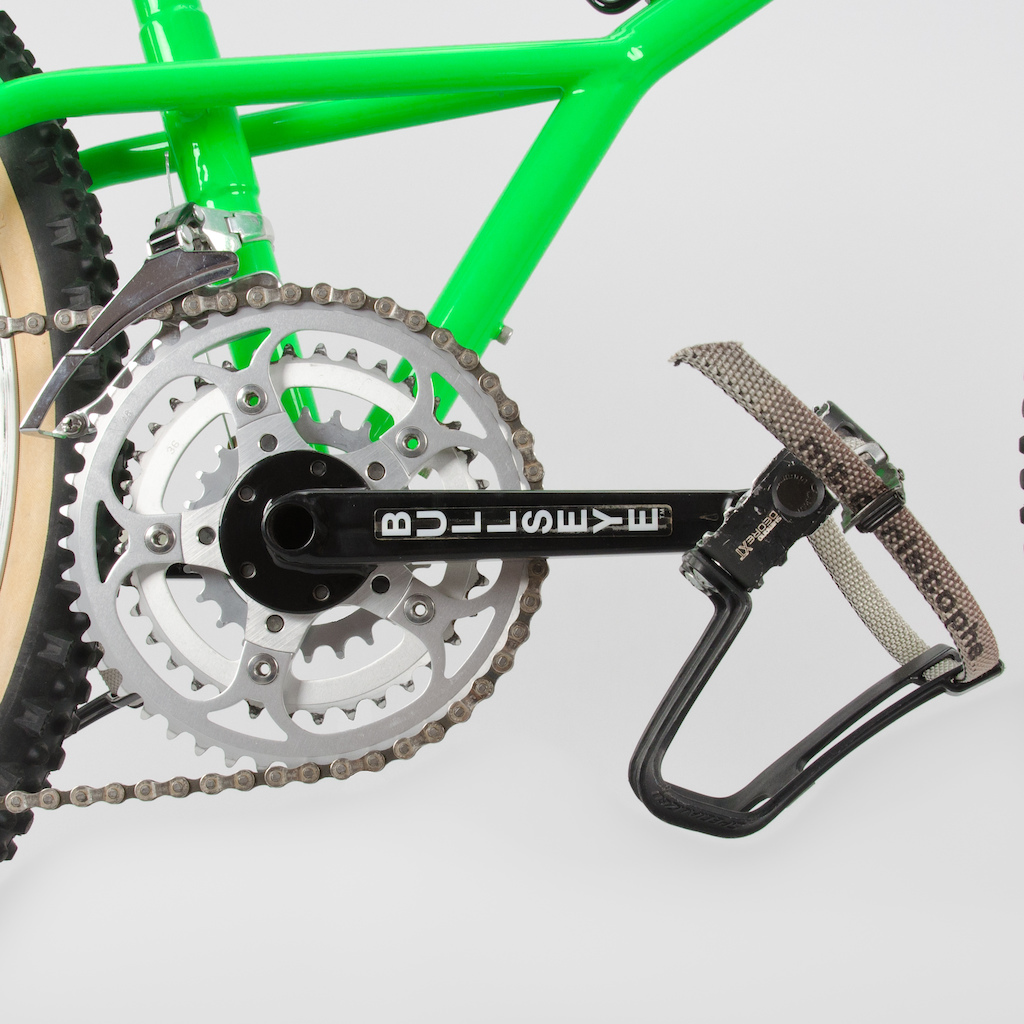Now THAT Was a Bike: 1990 Mantis Valkyrie
Some readers may know that I made mountain bikes back when the sport was in its infancy and the vintage bike featured here, a 1990 Mantis Valkyrie, was one of them. The bike was beautifully restored by the Vintage MTB Workshop in the factory racing color that customers affectionately dubbed, "Tree Frog Butt Green," and is presently on loan to the Pro's Closet's museum. I rode one that was the same color and size for a number of years and it remains one of my favorites to this day. It was one of those rare designs where the good and bad traits blend together to produce a magical ride. I find it a bit awkward to be featuring a bike which I created here on Pinkbike, but I chose to because the unusual configuration of the Valkyrie frame and its boutique component spec recall a much broader story - about a brief and rampant period of innovation when rivals often cooperated and a garage machinist or a man with a welding torch could compete on a level playing field with the industry's largest players.
An Unlikely Source of Inspiration
The X frame was conceived after Gary Fisher took offence to statements I had made about the failure mode of his Procaliber racing frames in an article that I had guest-written for Mountain Bike Action Magazine. To prove me wrong (which he did), Gary flew me up to his headquarters near San Anselmo, California, where he demonstrated the failure modes of his frames, and some other examples he had laying around. Using a load cell and a fork fixture that he had borrowed from Charlie Cunningham over at Wilderness Trail Bikes, Fisher duplicated the forces of a head on collision by cranking down on a huge turnbuckle that pulled a solid steel "fork" towards the frame's bottom bracket until the front triangle failed.
The X frame was conceived after Gary Fisher took offence to statements I had made about the failure mode of his Procaliber racing frames in an article that I had guest-written for Mountain Bike Action Magazine. To prove me wrong (which he did), Gary flew me up to his headquarters near San Anselmo, California, where he demonstrated the failure modes of his frames, and some other examples he had laying around. Using a load cell and a fork fixture that he had borrowed from Charlie Cunningham over at Wilderness Trail Bikes, Fisher duplicated the forces of a head on collision by cranking down on a huge turnbuckle that pulled a solid steel "fork" towards the frame's bottom bracket until the front triangle failed.
True to Fisher's word, the Tange Prestige Procaliber frames outperformed his chromoly models by double. As expected, the chromoly front triangles simply rippled and folded at about 350 pounds of tension when they failed. The heat-treated Prestige frames, however, would withstand over 700 pounds of tension and they didn't dimple when they failed. Instead, the tubes would nearly explode as they cracked apart somewhere near their midsections, where their butted walls were paper thin. Fisher had a welded, oversized-aluminum front triangle on hand that blew the steel frames into the weeds by sustaining over 1200 pounds tension without failure. But, the a-ha moment for me happened when Fisher, out of pure curiosity, grabbed a rusted, 1940's era Schwinn Excelsior frame off the floor and hooked up the apparatus to it. It was a cantilever type frame - the kind that has an extra pipe that runs between the seat tube to the down tube near the frame's steering head. The Schwinn, with its one-inch-diameter mild-steel pipes nearly reached a thousand pounds on the load cell, and when it failed, it could still support 300 pounds of tension.
The head tube junction of a classic diamond frame is its weakest point. I didn't need Gary's demonstration to understand that. The strength of the Schwinn, however surprised us both. I realized that by simply triangulating the head tube area of a steel frame that I could use smaller, lighter-weight tubes and end up with a frame that was immensely stronger than its predecessors. I started working on the design on the flight home.
Originally, the Valkyrie was designed with conventional chainstays, and the handful that we built have become very popular among collectors. We switched to elevated chainstays around 1989 as a work-around to escape the confinements imposed by narrow rear hub and bottom bracket standards of that period. Large-diameter chainrings and an inboard chain-line restricted the space available around the rear tire and the sprockets to a few millimeters for designers who wanted chainstays shorter than 17.5 inches. Redirecting the chainstays over the bottom bracket area eliminated those issues altogether and allowed us to use short stays and "big" tires without clearance problems - and to avoid frame damage due to chain fouling, which was then a common occurrence.
The twin tubes that triangulate the frame serve as reinforcements to the head tube area, and also function to provide stand-over clearance. Back then, the longest commercially produced seat posts were 280-millimeters and while longer ones could be had from a boutique parts maker like IRD, oversized seatpost diameters had not yet gained acceptance and frames with long, slender seatposts were as flexible as tent poles. Twin struts allowed me to dramatically slope the top tube to get the stand-over clearance I wanted, while allowing for seatposts of reasonable lengths. The same concept is mirrored by today's frame designs, although the braces are smaller and simpler shapes.

The union of the bridge that connected the seat stays to the seat tube proved to be a weak point, I calculated the stress there believing that jumps and G-outs would create the highest loads, but it turned out that chain tension was much higher - up to 1100 pounds. I had to repair a number of cracked frames. This one was fixed by another builder.
Valkyries were a bit of a retro design for me, I had already moved most frame construction at Mantis from steel to oversized aluminum, and most welding was done with a modern TIG welder. Valkyries were a step back to steel construction, and their triangulated look reminded me of the British-made custom motorcycles that I lusted after in the '70's. The tubes I used were very thin, so with the exception of the bottom bracket junctions, X-frames were brazed together using an acetylene torch. I did all the welding on those frames, often while speaking on the telephone with customers. Most frame builders who use the fillet (fill-it) brazing method finish-sand the joints smooth. Having had a torch in my hand since I was in high school, however, I was pretty good at the technique, so to show off to fellow builders, I left the welds untouched. (I am pretty sure that nobody ever noticed).
Cottage Industry Component Makers
Bucking the norm is guaranteed to create problems and the Valkyrie had its own list of issues, the worst of which was that the X-frame's compact rear triangle was too short to route the saddle wires of conventional cantilever brakes behind the seat tube, so the wires had to be guided around the tube and the saddle connected on the front side. Even when set up perfectly, cantilever brake performance was less than inspiring. Fortunately, I wasn't the only designer who ran into that problem and help came in the form of the purple parts makers - ex aerospace machinists, like IRD's Rod Moses, who recognized that bike designs and riders' skillsets were progressing as quickly as big name component makers were falling behind. They were riders themselves, so they got it - and together they re-invented virtually every component on the bike to fill the growing performance void. A number of side-pull type brakes appeared, like the IRD Widget and Rotary designs on our featured bike, which handily solved the problem.
Most of the components that Vintage MTB Workshop used to complete the restoration are aftermarket items which came from that brief cottage industry bloom, which gave birth to almost every important innovation that created the modern mountain bike: Wide hubs and bottom brackets with sealed cartridge bearings, two-finger levers, offset crankarms, oversized and threadless headsets, dropper seatposts, through-axle hubs, tubular bottom bracket axles, open-face stems, disc brakes, suspension - and the list goes on. Sure there were a lot of crap products, but it is indisputable that the mountain bike industry is still harvesting the benefits of seeds sewn by the rule-breakers of the late '80s and early 90s.
The Bullseye crankset is a welded chromoly assembly that could have been the prototype for the present Shimano XT and XTR, with its integrated tubular axle and drive-side crank arm, pass-through sealed bearing bottom bracket and splined left-side interface. One of the bike's rarest features is the IRD remote seatpost quick release, paired with a Breeze-Angel Hite-Rite dropper spring. Correctly assembled, the Hite-Rite would keep the saddle lined up while its owner manually operated the quick-release clamp. IRD's cable-remote arrangement, powered by an early Suntour thumb-shift lever, will silence any doubts that the dropper post preceded the freeride movement.
Bucking the norm is guaranteed to create problems and the Valkyrie had its own list of issues, the worst of which was that the X-frame's compact rear triangle was too short to route the saddle wires of conventional cantilever brakes behind the seat tube, so the wires had to be guided around the tube and the saddle connected on the front side. Even when set up perfectly, cantilever brake performance was less than inspiring. Fortunately, I wasn't the only designer who ran into that problem and help came in the form of the purple parts makers - ex aerospace machinists, like IRD's Rod Moses, who recognized that bike designs and riders' skillsets were progressing as quickly as big name component makers were falling behind. They were riders themselves, so they got it - and together they re-invented virtually every component on the bike to fill the growing performance void. A number of side-pull type brakes appeared, like the IRD Widget and Rotary designs on our featured bike, which handily solved the problem.
Most of the components that Vintage MTB Workshop used to complete the restoration are aftermarket items which came from that brief cottage industry bloom, which gave birth to almost every important innovation that created the modern mountain bike: Wide hubs and bottom brackets with sealed cartridge bearings, two-finger levers, offset crankarms, oversized and threadless headsets, dropper seatposts, through-axle hubs, tubular bottom bracket axles, open-face stems, disc brakes, suspension - and the list goes on. Sure there were a lot of crap products, but it is indisputable that the mountain bike industry is still harvesting the benefits of seeds sewn by the rule-breakers of the late '80s and early 90s.
The Bullseye crankset is a welded chromoly assembly that could have been the prototype for the present Shimano XT and XTR, with its integrated tubular axle and drive-side crank arm, pass-through sealed bearing bottom bracket and splined left-side interface. One of the bike's rarest features is the IRD remote seatpost quick release, paired with a Breeze-Angel Hite-Rite dropper spring. Correctly assembled, the Hite-Rite would keep the saddle lined up while its owner manually operated the quick-release clamp. IRD's cable-remote arrangement, powered by an early Suntour thumb-shift lever, will silence any doubts that the dropper post preceded the freeride movement.
 Add IRD's Remote Seatpost Quick Release to a Breeze-Angel Hite-Rite and you get the seminal dropper - circa 1989
Add IRD's Remote Seatpost Quick Release to a Breeze-Angel Hite-Rite and you get the seminal dropper - circa 1989Technical Details
• Year: 1990
• Serial number: VK1912
• Frame: Mantis Valkyrie
• Fork: Mantis Straight Blade
• Stem: Salsa Moto
• Headset: Shimano Deore XT
• Bottom Bracket: Bullseye Sealed Bearing
• Handlebar: Salsa Merlin Titanium
• Shifters: Shimano Deore XT Thumb shifters
• Front Derailleur: Shimano Deore XT
• Rear Derailleur: Shimano Deore XT
• Brake Levers: Shimano Deore XT
• Front Brake: IRD Widget
• Rear Brake: IRD Rotary
• Crankset: Bullseye
• Chainrings: Sugino 26-38-48
• Pedals: Shimano Deore XT M731
• Hubs: Bullseye Cartridge Bearing
• Rims: Matrix Mountain Titan
• Tires: Onza Porcupine
• Wheel QR: Ringle Cam Twist
• Seatpost: IRD
• Saddle: Selle Italia Turbo
• Seatpost QR: IRD Remote
• Grips: ODI Tomac Attack
• Cogs: Sachs Freewheel
• Chain: Shimano HG
• Remote seat clamp shifter: Suntour
• Serial number: VK1912
• Frame: Mantis Valkyrie
• Fork: Mantis Straight Blade
• Stem: Salsa Moto
• Headset: Shimano Deore XT
• Bottom Bracket: Bullseye Sealed Bearing
• Handlebar: Salsa Merlin Titanium
• Shifters: Shimano Deore XT Thumb shifters
• Front Derailleur: Shimano Deore XT
• Rear Derailleur: Shimano Deore XT
• Brake Levers: Shimano Deore XT
• Front Brake: IRD Widget
• Rear Brake: IRD Rotary
• Crankset: Bullseye
• Chainrings: Sugino 26-38-48
• Pedals: Shimano Deore XT M731
• Hubs: Bullseye Cartridge Bearing
• Rims: Matrix Mountain Titan
• Tires: Onza Porcupine
• Wheel QR: Ringle Cam Twist
• Seatpost: IRD
• Saddle: Selle Italia Turbo
• Seatpost QR: IRD Remote
• Grips: ODI Tomac Attack
• Cogs: Sachs Freewheel
• Chain: Shimano HG
• Remote seat clamp shifter: Suntour
